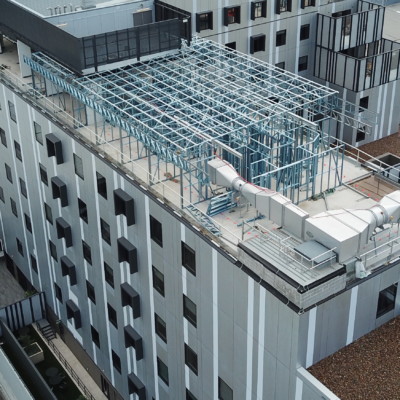
#24 Next Generation of Robust and Fire-resilient Light Gauge Steel Systems for Mid-Rise Buildings (Umbrella Project)
This project will investigate the fire resistance behavior of light gauge steel (LGS) floor ceiling systems made of high strength lipped channel sections and truss configurations. It will use small-scale and full-scale fire tests and advanced numerical modelling. It will consider the commonly used sub-floor and ceiling materials, investigate the mechanical properties of floor and ceiling materials and associated connections at ambient and elevated temperatures, and study their effects on the fire resistance levels (FRLs) including those of board fall-off. It will develop FRL tables and spreadsheet-based design tools for all the selected LGS floor configurations for inclusion in fire design handbooks.
Light gauge steel (LGS) offers significant advantages over other construction materials such as easy to install and resistant to rotting, shrinking and termite attack. However, the structural robustness to resist progressive collapse under localised damage due to accidental loads is a critical concern in LGS systems. This is particularly the case given the connections in LGS buildings are usually made via screws and rivets with low tying resistance.
This project will develop cost-effective structural solutions for robustness of LGS structures to promote their applications in mid-rise construction markets such as offices, apartments, hotels, hospitals, student accommodation and aged care facilities.
Researchers on project include: Prof. Mahen Mahendran, Dr Anthony Ariyanayagam, Mr Fatheen Hisham, & Mr Gihan Ranasinghe. Prof Tuan Ngo, Prof Nelson Lam, A/Prof Tai Thai, Dr Tuan Nguyen, Mr Chris Mathwin, Mr Trac Nguyen.
PUBLICATIONS
- January 2025 – Improving the fire resistance of light steel floor-ceiling systems through enhanced materials and construction methods
- December 2025 – Behaviour of LSF truss floor-ceiling systems under standard fire conditions
- December 2025 – Experimental and numerical studies of LSF truss floor-ceiling systems under standard fire conditions
- November 2025 – Numerical modelling of LSF truss floor-ceiling systems made of top hat sections
- October 2025 – Fire tests of full-scale LSF floor systems
- October 2025 – Numerical analysis and design approach for mid-rise cold-formed steel load-bearing wall buildings to resist progressive collapse
- October 2025 – Numerical modelling of light gauge steel framed floors under standard fire conditions
- June 2025 – Effects of combustible electrical sockets on the fire resistance of LSF walls
- March 2025 – Experimental study of LSF truss floor-ceiling systems made of top hat sections
- February 2025 – Simplified finite element model for screwed connections with clip angle
- January 2025 – Fire tests of CFS stud walls with openings for combustible service pipes
- January 2025 – Numerical modelling of LSF floors under fire conditions
- November 2024 – Fire tests of short-span LSF floor systems made of lipped channel joists
- October 2024 – Horizontal tying force design for new connections of cold-formed steel structures
- August 2024 – An experimental study of cold-formed steel connections with screwed clip angle under tension and shear loads



